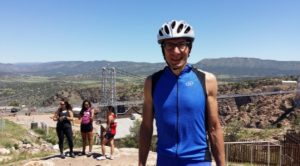The premise of this profile is to compare and contrast high-end steady state aerobic efforts with high-intensity anaerobic intervals. Both have benefits and should be part of every athlete’s training regimen. They are both hard. However, one or the other may be more difficult for an individual, depending on their muscle composition. People who are genetically endowed with a higher percentage of slow-twitch muscle fibers will tend to perform better during longer bouts of high-end aerobic activity, while those oriented more toward HIIT will have more fast-twitch fibers. As an example, compare the bodies of a sprinter like Usain Bolt (fast-twitch) to a distance runner such as Meb Keflezighi (slow-twitch). In the cycling world, there are distinct groups. Mark Cavendish and Andre Greipel typify sprinters, while Chris Froome and Nairo Quintana are very strong climbers.
A simple explanation, which you can share with your class, is that there are basically two types of muscle fibers in every individual—slow-twitch (Type I) and fast-twitch (Type II). Slow-twitch muscles are packed with mitochondria using oxygenated blood and provide their own source of energy, so they can contract for an extended period of time. But, they are not able to generate a significant amount of force. That’s best handled by fast-twitch muscle fibers, which are activated only when the force demands are greater than the slow-twitch fibers can meet. These muscles are much quicker to fatigue than slow-twitch.
We all have both types of muscle fibers, but the distribution can vary significantly with each person. Although trainable, with some limited ability to convert one muscle type to the other, an individual’s body composition is heavily influenced by genetics. If you want to be a great endurance athlete, it helps to have parents with a preponderance of slow-twitch muscles. Conversely, if your goal is to be a sprinter, powerlifter, or physique competitor, you’ll hope you have inherited a lot of fast-twitch muscles. Choose your parents wisely.
Ride Inspiration
 The inspiration for this profile was my own personal experience during the 2014 Ride the Rockies, a week-long organized ride through the mountains in Colorado. On the second to last day, I passed a former professional cyclist on a climb. Me, a skinny old guy with modest athletic accomplishments, climbed faster than Nelson Vails, who was a silver medalist in cycling in the Olympics.
The inspiration for this profile was my own personal experience during the 2014 Ride the Rockies, a week-long organized ride through the mountains in Colorado. On the second to last day, I passed a former professional cyclist on a climb. Me, a skinny old guy with modest athletic accomplishments, climbed faster than Nelson Vails, who was a silver medalist in cycling in the Olympics.
The difference is our body types. (His arms are bigger than my legs!) Nelly excelled on the track, which is about speed and power. I can hold my own in the mountains since it requires long, steady climbs at threshold. My body is made up of predominantly slow-twitch muscle fibers, while Nelly’s is primarily fast-twitch.
This ride is based on my own personal experience. Instructors, you can use it as written, referring to me in the third person rather than the first person, or simply use it as a comparison between “Rider A” who is more slow-twitch and “Rider B” who is more fast-twitch.
Note: This is not the first time ICA has offered a profile highlighting the difference between the muscle fibers. Tom Scotto’s brutal Betwitched profile is similar in concept, but he presents it in a very different way than Bill Pierce’s practical application on the Ride the Rockies bike tour.
Enjoy!


Hi Bill, thank you again for this great profile. I did this one about 6 months ago and then again tonight, the class loved it, I had some great feedback. Just love educating the riders while they cycle, it really got them thinking. I just need a nice anecdote like yours (Nelly & Bill) now..????
Caroline – I’m glad that you and your class liked it. It’s one of my favorite profiles. I’ll need to update my anecdote for this ride as well since Nelly wasn’t a participant at Ride The Rockies this past year. Perhaps he dropped out because of the humiliation he felt from being up the hills by a skinny old guy.
Hey Bill…I used Froome and Cavendish. At the end of the ride I asked them who were they more like…it was pretty even!! I am def a Froome girl! haha The HIIT 30 sec pieces killed me.
Lynda – Froomie versus Cav is a fantastic comparison and a subtle way to reference the Tour your riders. When I did my TdF stage ride with my classes, I asked them if they remembered this profile and then used it to compare the sprinters (Cav, Kittel, and green jersey winner Sagan) with the GC and King of the Mountain contenders (Froome, Majka, and Quintana. They immediately understood my reference. Yeah, I hated the 30 second sprints also.
Hey Bill,
Me again….I had the luxury of finally taking a spin class instead of teaching one. The instructor did this same profile. When she started talking about Slow Twitch vs. Fast Twitch..I was pumped!! When I taught it I def had to scale back a bit so I could cue, motivate etc. I probably did not experience quite what my students did, UNTIL TODAY! I got to take my instructor hat and just ride. It was painful but crazy good. I think I cursed a few times…haha
Please keep bringing us your great profiles. I look forward to the next one! Ride On Bill!
Lynda – Great feedback. It sound like you had a blast taking a class that you’ve previously taught. I’m constantly creating new profiles and will contribute them to ICA when appropriate.
This was a huge hit in class last week. I actually did 4 sets of the intervals. Holy moly this was awesome and hard stuff. Most of my peeps know their FTP, some don’t but cued them based on on PE and zones. AMAZING! A true training profile! Thanks Bill. Keep bringing it!
Thanks for what looks like a really funnprofile! Question: in the 4 minute climb do we coach them to add gears, or do we just describe the effort an allow them to get there in their own time? I know you said they ca sit or stand as necessary, but I’m wondering how long they should take to get to max wattage. TIA!
Nina – Good question. First, I’d like to clarify that they never get to their ‘max wattage’ at any point during this ride. They come close during the 30 second anaerobic efforts, but not during the 4 minute threshold climbs. These are performed at threshold, right around 100% of FTP. The entire 4 minutes should be spent at that intensity and power level, coming right out of the recovery. Describing how it should feel is great cueing, especially if they don’t have power meters or know their own FTP. But, there’s no need to allow them to get their in their own time. A threshold effort is something that is sustainable for longer than 4 minutes, although it’s very uncomfortable. Depending on the bike, they can get there immediately to start the 4 minute threshold climb. Bikes that enable quick gear setting or resistance loading, like a Keiser, Stages, or Schwinn Carbon Blue, should enable riders to find the proper combination of load plus cadence quickly. Bikes that require several turns of a knob, like a Spinner (R), make take a few seconds to reach the target resistance level. Either way, they should be at threshold effort / 100% of FTP, very shortly after the climb starts.
Great-thanks for clarifying! So if we haven’t done FTP tests in my class, do you think it’s unwise to do the profile? Some of my folks do know what theirs is, but not all do. I feel fairly confident coaching the effort based on feeling cues and zones.
Nina – I strongly encourage you to try this with your class. Knowing their FTP is a bonus, but not a requirement. If you can cue based on perceived exertion and zones, you’ll nail it. Let us know how it goes.
I did it and they loved it! A couple of riders said that they were easily able to increase wattage by 20%-one woman said that she almost doubled hers. She said that she didn’t think she could go any steeper in the aerobic climb and keep the prescribed RPM’s. Should I coach at least 20 % more watts next time I do it?
Nina – If they were ‘easily’ able to increase their power by 20% when going from a 4 minute threshold interval to a 30 second HIIT interval, it could be because they are more like Nelly then like Bill. Or, it could be because their threshold effort was sub-threshold so 20% more would possibly put them at or just above threshold. The person who doubled their watts was almost certainly sub-threshold for the 4 minutes. If she didn’t think she could go any steeper and keep the RPMs, have her try rather than perceive it to be impossible. If it isn’t working, perhaps she can back off a bit. Threshold is uncomfortable, especially for fast twitch athletes, but it’s unlikely that it’s 50% less power than a HIIT effort.
Excellent! Thanks Bill! I love it! Going to use it this week. I’ll let you know how it goes!
Lynda – Good luck and have fun with it. I’ll be curious how it goes and whether you’ll use Rider A and Rider B, refer to me in the third person, or tell your class that you beat a former Olympic cyclist up a mountain.
Excellent profile, visuals and cues. Thank you, Bill!
I’m glad that you liked it. Depending on your beliefs, God or Mother Nature was responsible for the visuals. They were even more stunning in real life than the pictures depict.